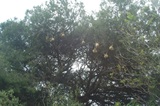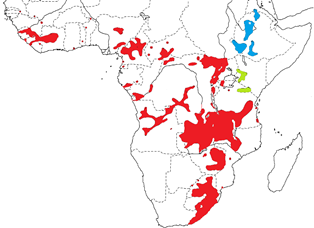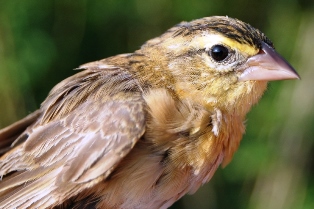Weaver species
Choose different species from drop-down list and press 'Go' button. See Full species list.Red-collared Widowbird Euplectes ardens
IUCN: Least concern Discovery: 012Categories: long tail, fruit, nectar, pest,
News items about species
Discovery
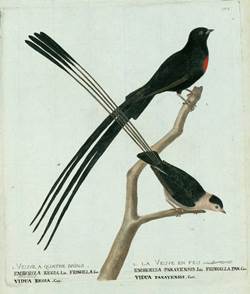
(with Shaft-tailed Whydah), figure from Buffon 1770 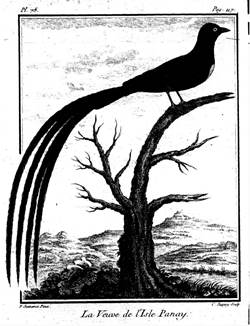
figure from Sonnerat 1776 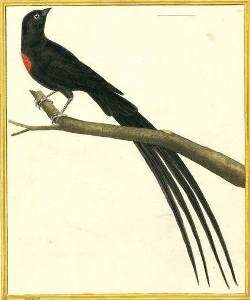
figure from Daubenton 1783 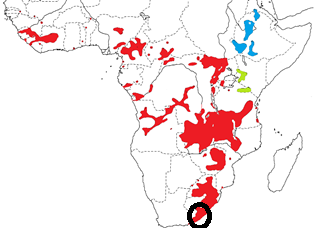
type locality circled IntroductionThe Red-collared Widowbird was formally named by Pieter Boddaert, a Dutch naturalist, in 1783. The background comments about Boddaert and the Count of Buffon are the same as listed under the Long-tailed Widowbird.Boddaert published the first Linnean binomial names (scientific names) for the Red-collared Widowbird. This species was illustrated in Edme-Louis Daubenton's book of illustrations - the coloured engravings by Francois-Nicolas Martinet were published in 1783 as Planches enluminees. But Buffon had also published an earlier version with a limited number of species in a book of plates in 1770, and the only weaver to feature here was the Red-collared Widowbird. The 1770 painting may have been painted by Martinet, but is different to the later version in 1783. Both paintings, however, show a red circle on the breast of the male widowbird instead of a collar. This may be due to the breast feathers being damaged between collection and arrival in Paris. Boddaert and Buffon gave this species the French name Veuve en feu, ie. burning widow, referring to the bright red breast colour in contrast to the rest of the black plumage. Boddaert also gave the scientific name based on the bright red on the breast of the male. Buffon noted that the bird originated from Cap de Bonne Esperance & a I'ile Panay, ie the Cape of Good Hope and Panay island in the Philippines. This was based on one of Buffon's many correspondents, Pierre Sonnerat. Sonnerat made several voyages to southeast Asia, visiting the Philippines and Moluccas between 1769 and 1772. He must have collected the Red-collared Widowbird in 1769 (or 1770) in South Africa en route from the Philippines to France, where Buffon illustrated it in 1770. Sonnerat published his travel diary in 1776 and also listed this widowbird from "Cap de Bonne Esperance & a I'ile Panay". Why he listed Panay Island is not clear. The Cape of Good Hope could mean the Cape in its broadest sense, ie either the Western or Eastern Cape. Mackworth-Praed & Grant 1955 restricted the locality to the Eastern Cape, as the Red-collared Widowbird does not occur in the Western Cape. Buffon had many correspondents who sent him specimens from different places in the world, but no details are published for the Red-collared Widowbird as to who collected this species. Scientific citationFringilla ardens Boddaert 1783 Tabl. Planch. Enlum., p39 Cape of Good Hope, S Africa (ex Daubenton, Planch. Enlum., pl 647). Restricetd to E Cape.Meaning of namesardens (Latin) = glowing, burning (ardere, to burn).First English nameThe Fire-coloured Widow (Buffon 1793).Alternate namesBlack Widowbird, Cut-throat Widow-bird, Flaming Whydah, Red-Hooded Whydah, Red-naped Widowbird.CollectorPierre Sonnerat.Date collectedBetween 1769-1770, when Sonnerat visited the Philippines (and before the publication of Buffon's 1770 colour engraving of the species).Locality collectedEastern Cape, South Africa.Type specimensNo type specimens known to survive, but the painting of Buffon serves as a type. |
The above is based on Weaver Wednesday 2, a weekly series about the discovery of each weaver species.
This species text first appeared as
Weaver Wednesday [129] - Discovery [12]: Red-collared Widowbird on 2014-12-03
1. Basic biology
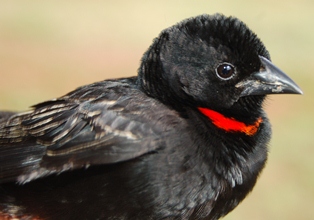
adult male, S Africa 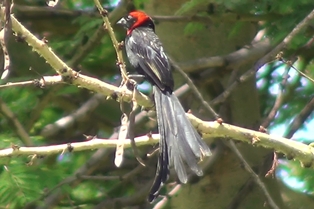
adult male, Kenya Identification. The adult male Red-collared Widowbird Euplectes ardens in breeding plumage (above left) is black, often with a red collar or head, and a long tail. Females (below) and non-breeding males are dull coloured, with a yellowish eye-stripe and yellowish or buffy breast sharply demarcated from the white belly.
Distribution.
The Red-collared Widowbird is a widespread widowbird in Africa, being found from Senegal across to Ethiopia and south to eastern South Africa in the localities shown on the map below (based on Birds of Africa). Many subspecies have been recorded. Currently accepted subspecies are:
The highland laticauda and suahelicus are isolated from the Iowland birds and from each other, and may be separate species. Molecular studies indicate that the Red-collared Widowbird is a bishop with a long tail, rather than a widow.
Habitat. It occurs in a variety of habitats including grassland, rank vegetation, cultivated areas, and slopes with sparse trees. Food. The Red-collared Widowbird feeds on seeds, insects including termites, nectar. It forages on the ground, often in flocks of 200 birds or more. Breeding. This species is polygynous and territorial. Males with longer tails attract more females and males with larger red collars held larger territories. Males prefer hillsides, where they can glide downhillfor display flights. The nest is an oval structure with a side entrance, built by the male and lined and strengthened by the female. A male may have 3-22 nest structures placed in tall grass, on his territory. The eggs are grey or blue-green and heavily speckled with brown, often forming ring near the thick end (see photo at phown 2411). |
The above is based on Weaver Wednesday, a weekly series about weaver species.
This species text first appeared as
Weaver Wednesday [19]: Red-collared Widowbird on 2012-10-24
2. Breeding facts
| Pair bond Polygynous, male typically with two or three females Breeding season Oct-Nov in Sierra Leone, Sept-Oct in Liberia, Sept-Nov in Nigeria and Cameroon, Apr-May and Jul-Oct in Ethiopia; in DRCongo, Sept-Nov in NE and Jan-May in SE; Mar-Apr in Rwanda, Apr-Jun in Uganda, Apr-Jul and Dec-Jan in Kenya, and Jan-May in Tanzania; Jan-Apr in Zambia and Jan-May in Malawi; in Mozmbique, Feb-May in W and Oct-Mar in S; Dec-Mar Zimbabwe and Oct-Mar in South Africa Nest site placed 1-3.5 m above ground in tall elephant grass, elsewhere often less than 1 m above ground Nest building female often does most of building, continues to add lining during incubation period Colony size territory containing 3-22 nest structures Clutch size 2-4 eggs (mean 2.7 in South Africa) Egg colour greyish or blue-green, heavily speckled with brown, often forming ring near thick end Egg size average size of 149 eggs 18.9 x 13.6 mm (South Africa) Incubation incubation by female only, period 12-15 days Chicks and nestling period chicks fed by female only, primarily by regurgitation, nestling period 14-17 days |
Breeding information based on Handbook of the Birds of the World, Vol. 15.
3. Photos of Weaver Nests
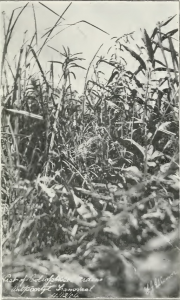 Vm 5182 |  Vm 2411 |
Thumb-nails of most recent PHOWN records - click on one to see its full record
See all PHOWN records for this species here.
PHOWN (Photos of Weaver Nests) provides valuable info on breeding distribution and colony sizes of weavers.
You can contribute by registering and submitting photos at Virtual Museum webpage.
4. Breeding distribution
Google map showing distribution (For species with small ranges you need to zoom in at the correct area to see the range):
yellow blob - range of weaver species; read more about this here.
![]() - PHOWN records with photos
- PHOWN records with photos
![]() - PHOWN records with no photos (Nest Record Cards, other records)
- PHOWN records with no photos (Nest Record Cards, other records)
![]() - Birdpix records
- Birdpix records
![]() - comments on out of range records, or interesting records
- comments on out of range records, or interesting records
![]() - type locality
- type locality
CLICK on the marker on the map to see individual record details.
5. Range changes
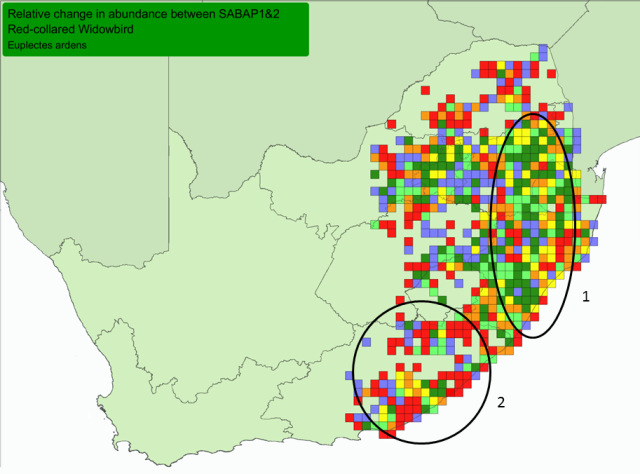
Red, orange and yellow = cells with very large, large, and small relative decreases Blue, dark green and light green = cells with very large, large and small relative increases. Cells = quarter-degree grid cells; Only cells with at least 4 checklists in both SABAP1&2 shown. All cells had this species recorded in SABAP1 or in SABAP2 or in both (more about interpretation at Biodiversity Observations 7.62: 1-13).
Range changes in SA
The points below match the points on the map above. 1. The core range of this widowbird in South Africa lies from eastern Mpumalanga to southern KwaZulu-Natal, excluding Zululand (this core has high reporting rates in SABAP2)
Overall the Red-collared Widowbird shows a fairly stable population between SABAP1 and SABAP2. There are many grids with large or small changes, but these are fairly patchy. Range changes elsewhereNo major range changes known elsewhere, but it may wander in response to rainfall, eg. recorded 170km west of its known range at Selukwe, Zimbabwe, probably due to rainfall (Donnelly 1973a). | |||||||||||||||||||||||||||||||||||
The above is based on Weaver Wednesday 3, a weekly series about range changes in South African weaver species.
This species text first appeared as
Weaver Wednesday 3 [258] - Range changes [21]: Red-collared Widowbird on 2017-05-24








